*The values used in this article are as of 2022-2023.
In this article, we’ll examine whether 17 MPG, or 13.84 L/100 km, is a reasonable fuel economy for a general automobile, and then we will discuss 17 MPG for specific vehicle types.
The focus will be on combined fuel economy. We will, however, briefly discuss city and highway fuel economy.
Is 17 MPG Good?
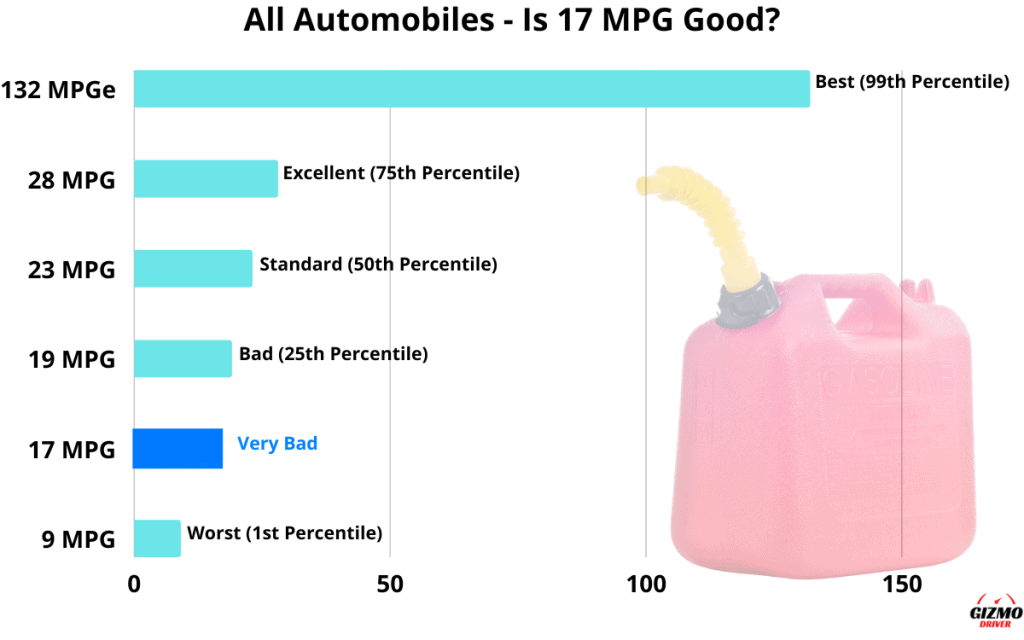
For the average vehicle, 17 MPG is a very bad gas mileage. A 17 MPG car is 26% less fuel efficient than the median vehicle, which gets 23 MPG. For specific vehicle types, 17 MPG is the standard (50th percentile) gas mileage for full-size SUVs (such as a GMC Yukon).
The following tables show how good 17 MPG is for several types of vehicles.
| Vehicle Type | Median Fuel Economy | 17 MPG is | 17 MPG/Median Difference |
|---|---|---|---|
| All Automobiles | 23 | Very Bad | – 26.09% |
| Sedan | 28 | Terrible | – 39.29% |
| Small SUV | 27 | Terrible | – 37.04% |
| Large SUV | 21 | Bad | – 19.05% |
| Sports Cars | 19 | Bad | – 10.53% |
| Pickup Truck | 18 | Substandard | – 5.56% |
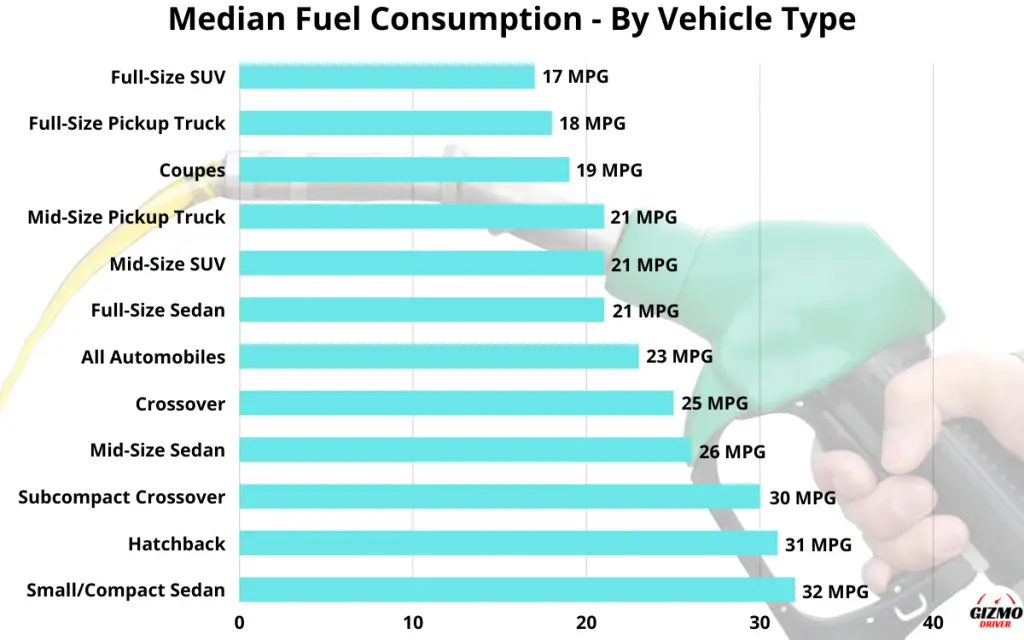
As we can see in this chart, 17 MPG is within the 50th percentile for full-size SUVs and below the median for all other major vehicle categories.
The median is a better measure of assessing whether or not 17 MPG is good. Electric vehicles and plug-in hybrids can significantly inflate average gas mileage values.
For example, we calculated that the average MPG for a pickup truck is 20.6 miles per gallon. However, 20.6 MPG is above the 70th percentile for all pickup trucks. That means for every 10 pickup trucks, 7 get lower gas mileage than the average of 20.6.
The median MPG, or 50th percentile, much better reconciles the large efficiency gap between electric and gas-powered vehicles.
17 MPG – City
17 MPG in the city is not good. The median car (50th percentile) gets 20 MPG in the city.
For a vehicle that uses regenerative braking, 17 MPG in the city is extremely very poor. In the city, the typical hybrid (MHEV/HEV) vehicle achieves 23 MPG.
The fuel efficiency of a vehicle in the city is typically lower than its efficiency on the highway. Full-hybrid cars, on the other hand, are often more efficient in the city than on the highway because of regenerative braking systems.
17 MPG – Highway
On the highway, 17 MPG is terrible fuel economy. It’s well below the median of 27 miles per gallon for highway driving. That’s a difference of 10 miles per gallon. Typically, a 17 MPG highway rating translates to a combined (city/highway) gas mileage of 14-15 MPG for most vehicles.
The cost of 17 MPG
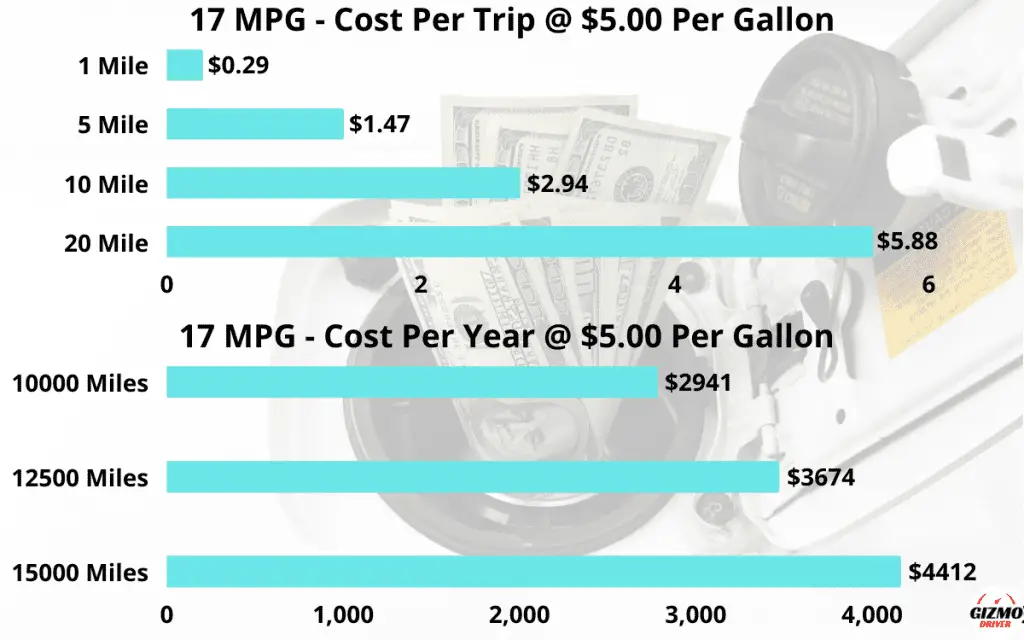
You will pay much more to drive a car that gets only 17 MPG than the average car.
At $5.00 per gallon, a vehicle that does 17 MPG will generally cost you $0.29 per mile. A 15-mile commute to work will cost you $4.35 in gas.
When driving 15,000 miles per year, the annual cost of fuel for a car that gets 17 MPG is $4412. At 17 MPG, you spend $1150 more on gas than the median car.
How many miles is 17 MPG?
MPG is a measurement of how far your car can travel per gallon of gas. So, at 17 MPG, your car can cover a distance of 17 miles, or 27.35 kilometers, for every gallon of fuel. A 17 MPG car with a fuel capacity of 15 gallons can travel up to 255 miles before having to refuel.
17 MPG in L/100 km
17 MPG is 13.84 L/100 km. That means you burn 13.84 liters of fuel for every 100 kilometers driven.
At 13.84 L/100 km, you can go 7.23 km with one liter of gas.
17 MPG on SUVs
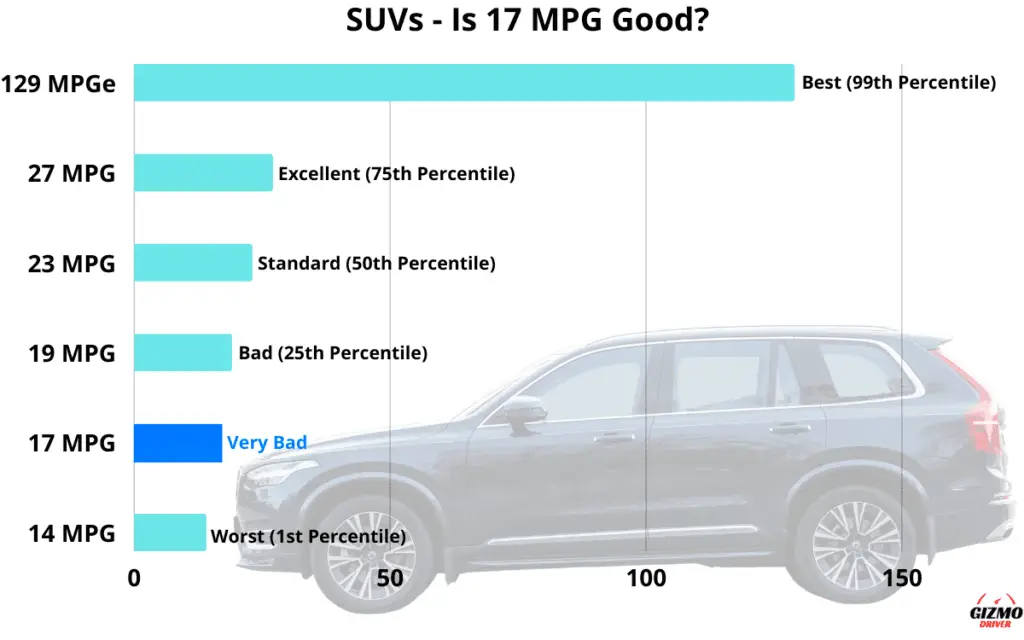
For all SUVs, 17 MPG is regarded as poor fuel efficiency. However, there are a lot of factors to take into account before deciding whether or not 17 MPG is good fuel economy for a particular vehicle.
For example, 17 MPG might be decent gas mileage for a large SUV with a V8 engine but horrible for a small 4-cylinder SUV.
There are 2 main categories and 4 subcategories for SUVs: full-size and mid-size SUVs fall into the large SUV category, while compact and subcompact SUVs fall into the small SUV category.
To get a better idea of what you can consider good fuel economy for an SUV, please check out our articles covering the fuel economies of large SUVs and small SUVs.
We’ll take a look at each subcategory.
Full-size SUVs:
Concerning full-size SUVs, 17 MPG is the average (median) fuel economy. It is above the 50th percentile for gas mileage. Full-size SUVs typically get average gas mileage of between 16 and 18 miles per gallon.
17 MPG is usually seen in the more powerful full-size SUV trims, typically fitted with 8-cylinder engines.
The 2023 Chevrolet Tahoe, which has a 5.3 L, 8-cylinder gas engine, is a full-size SUV that achieves an average gas mileage of 17 MPG.
Mid-size SUVs:
For a mid-size SUV, 17 MPG is considered very low gas mileage. It is 4 miles less than the median MPG for the segment, which is 21 MPG. 17 MPG is below the 25th percentile of the gas mileage for mid-size SUVs.
17 MPG is generally seen in the 8-cylinder mid-size SUVs.
The 5.7 L, V8 2023 Jeep Grand Cherokee is a mid-size SUV that gets 17 miles per gallon.
Compact SUVs:
For compact SUVs, 17 MPG is considered extremely poor fuel economy. It is 33% lower than the median and is at the lowest percentile of the gas mileage for all compact SUVs. The median fuel economy for this segment is 25 MPG.
17 MPG is seen in the most power-hungry performance compact SUVs. An example of an SUV that gets 17 MPG is the 2023 BMW X3M and X4M, which both have a 3.0 L 6-cylinder engine producing over 500 hp.
Subcompact SUVs:
17 MPG is the worst gas mileage you can get on a subcompact SUV. No subcompact SUV is meant to get an average fuel economy of 17 miles per gallon.
If you are getting 17 MPG or less on a subcompact SUV, it is likely due to poor driving habits or conditions. If not, then you should have the car inspected in a garage.
The subcompact SUV with the lowest gas mileage is the 2.0 L 4-cylinder Mercedes-Benz AMG GLA45 4matic, which gets 22 MPG.
17 MPG on Pick-up Trucks

Whether 17 MPG is good for a pickup truck mainly depends on what type of pickup truck you drive. The average mid-size gasoline pickup truck is 16% more fuel-efficient than its average full-size counterpart.
Pickup trucks that are fitted with bigger engines are typically expected to have a lower fuel economy than pickup trucks with smaller engines.
To get a better idea of what you can consider good fuel economy for pickup trucks, please check out our articles covering the fuel economies of mid-size and full-size pickup trucks.
Full-size trucks:
17 MPG is slightly below gas mileage for a full-size pickup truck. The median full-size pickup gets 18 miles per gallon. 17 MPG is around the 40th percentile for this segment
17 MPG is generally seen in full-size pickup trucks that have 8-cylinder engines. 8-cylinder pickup trucks get gas mileage of 19-14 MPG, with the median being 16 MPG.
An example of a full-size pickup truck that gets 17 MPG is the 5.7 L V8 RAM 1500.
Mid-size trucks:
17 MPG is not good fuel economy for midsize pickup trucks. It is at the lowest percentile of the gas mileage for this type of vehicle. The median MPG for this type of pickup is 21 miles per gallon.
17 MPG is at the lowest end of the gas mileage for mid-size pickup trucks. It is most often seen in the most powerful mid-size pickup trims. An example of a mid-size pickup truck that gets a combined fuel economy of 17 MPG is the 3.6 L 6-cylinder Chevrolet Colorado ZR2 4WD.
The absence of V8 engines in mid-size pickup trucks is primarily responsible for the significant difference between full-size and mid-size. A large proportion (40-50%) of full-size pickup truck models are equipped with V8 engines, which have very low gas mileage, averaging 16 miles per gallon.
However, when fitted with the same engine, mid-size pickup trucks have very similar fuel economy as their full-size counterparts despite the weight difference.
17 MPG on Sedans
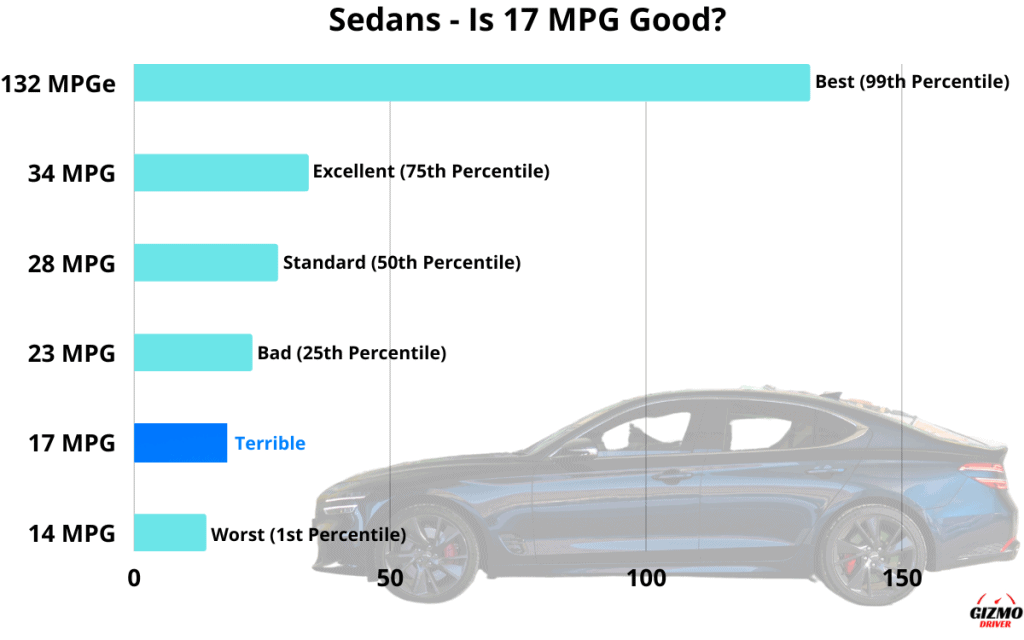
As we can see in the above chart, which illustrates the different percentile ranges for sedans, 17 MPG is considered horrible gas mileage for a sedan in general.
Depending on the type of sedan you drive, the answer may vary. For instance, 17 MPG may be considered average for a V8 performance sedan, but awful for a mid-size family sedan.
To get a better idea of what you can consider good fuel economy for a sedan, please check out our articles covering the fuel economies of every type of sedan vehicle.
Full-size sedans:
17 MPG is a very bad gas mileage for a full-size sedan. It falls below the 25th percentile and is 4 MPG lower than the segment’s median (50th percentile), which is 21 MPG.
17 MPG is the median gas mileage for 8-cylinder sedans.
An example of a full-size sedan that does 17 miles per gallon is the Bentley Flying Spur, which has a 4.0 L, 8-cylinder engine.
Mid-size sedans:
17 MPG is considered very bad for a mid-size sedan. It is 34.6% less fuel-efficient than the median mid-size sedan, which gets 26 MPG. Most mid-size sedans typically get an average gas mileage that is between 23 and 32 miles per gallon.
Mid-size sedans that get 17 MPG are 8-cylinder performance cars. An example of a 17 MPG mid-size car would be the 2023 4.0 L, 8-cylinder Audi RS7.
Small sedans (including hatchbacks):
You should not be getting 17 MPG on any given compact sedan. These cars normally do between 28 and 35 miles per gallon, with the median being 31.5 miles per gallon. Getting 17 MPG with a small sedan is likely due to very poor driving habits or road conditions.
Similar to subcompact SUVs, small/compact cars with 4-5 doors should not achieve 17 MPG. The compact car with the lowest fuel economy is the 2.4 L 4-cylinder Subaru WRX, which has a 21 MPG EPA rating.
17 MPG on Sports Cars

17 miles per gallon is around the 25th percentile of the gas mileage for sports cars, which is considered borderline bad. 17 MPG is acceptable for sports cars that have V8 engines; good for V10, V12, and even W16 engines; but bad for ones with 4-cylinder and 6-cylinder engines.
An example of a sports car that gets 17 MPG is the Dodge Challenger, which is fitted with a 6.4 L, V8 engine.
Conclusion
In a general sense, 17 MPG is a terrible gas mileage for most vehicles, as it is 6 miles per gallon lower than the median for all automobiles. However, with respect to full-size SUVs, 17 MPG is considered to be average fuel economy.

